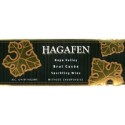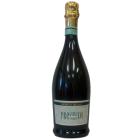#146 – October 21, 2010
With all the recent newsletter mentions of Champagne over in various contexts, I got to thinking that I hadn’t done a full-blown Champagne piece in a few years and that the time had come. That, together with an email suggestion from SG, led to the topic of this week’s newsletter – sparkling wines. Not Champagne, the title of which may only be bestowed upon the magnificent sparkling wine produced from grapes grown in France’s Champagne region; but rather the plethora of other delightful sparklers available from around the world (a Champagne piece is in the works and will come within the next few weeks).
Many of these sparkling wines made in countries encompassing the globe use special terms to define their own sparkling wines: Spain uses Cava, Italy calls its sparkling wine spumante or prosecco (depending on the region it is from), and South Africa uses the term Cap Classique. While the kosher wine market produces some truly terrible sparkling wines and even the better sparklers do not reach the level of depth and complexity of true Champagne, there are some truly fine possibilities out there which provide the fun drinking and good food-paring benefits of Champagne with the added benefit of being substantially cheaper in most cases.
For a long time my go-to sparkler was the 2001 Yarden Blanc de Blanc from the Golan Heights Winery which, like many of these sparklers, is made in the traditional Méthode Champenoise entailing the addition of sugar and yeast to the bottled wine which creates a second fermentation in the bottle. I will be writing more on production methods of Champagne and other sparkling wines in my Champagne piece to come. However, I am almost out of this wine and there are a number of other wines described below vying for that title and my dollars. The 2001 is somewhat hard to find with good provenance (i.e. from a retailer you trust to have stored the bottles appropriately) but I hope that the 2005 will be as widely available and fill that void for us.
![]() Elvi, Adar, Cava, Brut, n.v.: A blend of some very strange-sounding Spanish-bred grapes (Xarel-lo anyone?) resulting in a delightfully dry and simple Cava. Fruitier (strawberries?) than I usually prefer in such a lightweight sparkler but somehow it works, accompanied by tangy citrus and good tight bubbles. Any easy drinking, good-with-food Cava – just what simple Cava is supposed to be.
Elvi, Adar, Cava, Brut, n.v.: A blend of some very strange-sounding Spanish-bred grapes (Xarel-lo anyone?) resulting in a delightfully dry and simple Cava. Fruitier (strawberries?) than I usually prefer in such a lightweight sparkler but somehow it works, accompanied by tangy citrus and good tight bubbles. Any easy drinking, good-with-food Cava – just what simple Cava is supposed to be.
Golan Heights Winery, Gamla, Brut, 2007: I recently enjoyed this wine with my appetizer at the best place on earth – Gabriel’s in Jerusalem and it was perfect with my Foie Gras appetizer. Historically the Golan Heights Winery also produced a “Brut” wine as well as the Blanc de Blanc reviewed below but ceased production a few years back and shifted the grapes to be utilized in this wine – to great success. Loaded with the traditional green apple and yeasty notes you would expect from Champagne and livened up with sharp bubbles that linger on and on. A light and fresh alternative to the more serious Yarden Blanc de Blanc reviewed below, but just as crisply dry and refreshing, this wine should continue to delight for another five years or so (although I wouldn’t bank any additional improvement).
Yarden, Blanc de Blancs, 2001: This wine takes the cake for the best Champagne-type kosher wine available today and it is delectably priced as well. I loved the 1999 vintage, skipped the 2000 (as I had ample 1999 stock to carry me) and loved this vintage the most. That said, the 2005 vintage wine is also highly recommended. A great, subtle and elegant wine, with typical Champagne hints of toasted yeasty white bread and citrus on the nose and palate, along with apples, peaches and a hint of vanilla on the long creamy finish. A very long finish and sharp, fresh bubbles make this sparkler as sure a thing as you can find and a welcome addition to any festivities.
 Bellenda, Prosecco, Extra-Dry, n.v.: Tropical fruits, apricots and citrus all dance on your palate accompanied by crisp acidity and sharp tight bubbles that tingle in your mouth long after the last delicious drop of this wine are gone.
Bellenda, Prosecco, Extra-Dry, n.v.: Tropical fruits, apricots and citrus all dance on your palate accompanied by crisp acidity and sharp tight bubbles that tingle in your mouth long after the last delicious drop of this wine are gone.
Hagafen, Brut, Extended Disgorge, 2001: Champagnes typically sit on their lees (yeast deposits in a wine post-fermentation) for 12 – 18 months before disgorging (releasing those yeasts from the bottle). Extended Disgorge simply means the winemaker choose to extend the process as many feel that extended times on the lees adds a special breadth to the wine. While the chemistry of the process sometimes eludes me, the result is awesome. Extremely crisp and dry with grapefruit and lemon on both nose and palate together with the traditional toasted yeasty bread. The finish has a hint of sweetness – but only a hint – there is no sweetness to be seen in this wine. Drinking beautifully now I am not sure how much time the wine has in front of it (I’d guess 3-5 years)
 Hagafen, Brut Cuvee, 2007: Another hit by Hagafen and worth stocking up on. This wine has the same grape composition as the 2001 Extended Disgorge (78% Pinot Noir & 22% Chardonnay) but there are distinctive differences. More tropical fruit than citrus with some Pinot Noir flavors of raspberries showing nicely with hints of tannins as well. Sharper and longer bubbles than the Extended and lighter yeasty overtones as would be expected.
Hagafen, Brut Cuvee, 2007: Another hit by Hagafen and worth stocking up on. This wine has the same grape composition as the 2001 Extended Disgorge (78% Pinot Noir & 22% Chardonnay) but there are distinctive differences. More tropical fruit than citrus with some Pinot Noir flavors of raspberries showing nicely with hints of tannins as well. Sharper and longer bubbles than the Extended and lighter yeasty overtones as would be expected.
Tishbi, Brut, 2008: Not imported into the US and quite the shame as this wine is a worth addition to the Gamla and Yarden wines showcased above. As with most Israeli (and other better) sparklers, made in the Méthode Champenoise with French Colombard grapes. While these grapes can produce real drek, Tishbi has coaxed out their better half in this wine. Green apples pair nicely with toasty bread and grapefruit. A hint of spiciness makes this slightly different than your usually Champagne- type wine. Nothing complex but a nice sparkling for your random Wednesday afternoon or special occasion.
En Fuego, Reserva, Cava, n.v.: Made from more strange sounding grapes like Carel-lo, this is another nice, easy-drinking Cava with lemons, grapefruit, peaches, melon and toast. Good tart acidity and bubble vie for your attention and make this a great food-pairing wine – the hallmark of a good Cava. Good tight bubbles and a lingering tannic finish make this a truly pleasurable (and affordable wine).
 Borgo Reale, Prosecco, n.v.: For many years I have stayed away from the Borgo Reale line finding very little to perk my senses but things seem to be turning around lately. At SG’s suggestion I included this wine in my tasting and was happily rewarded with a fresh and crisp tasting wine with nice hints of peaches and apricots to go with the more traditional toast and yeast. Good bubble and a somewhat short finish round out this crowd pleaser.
Borgo Reale, Prosecco, n.v.: For many years I have stayed away from the Borgo Reale line finding very little to perk my senses but things seem to be turning around lately. At SG’s suggestion I included this wine in my tasting and was happily rewarded with a fresh and crisp tasting wine with nice hints of peaches and apricots to go with the more traditional toast and yeast. Good bubble and a somewhat short finish round out this crowd pleaser.